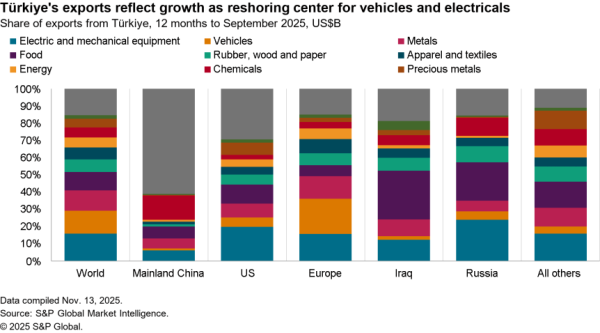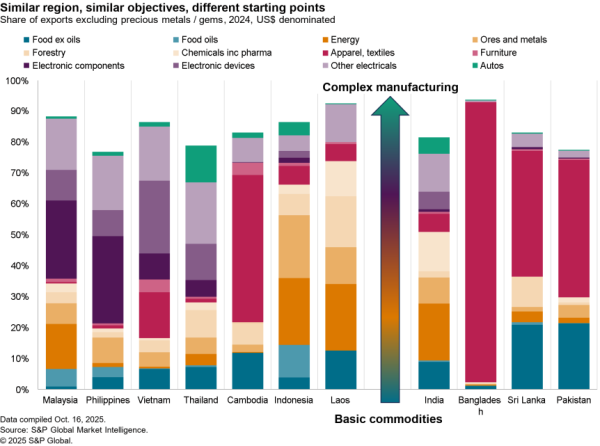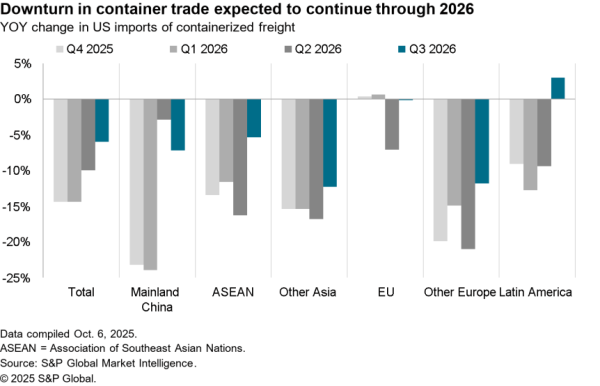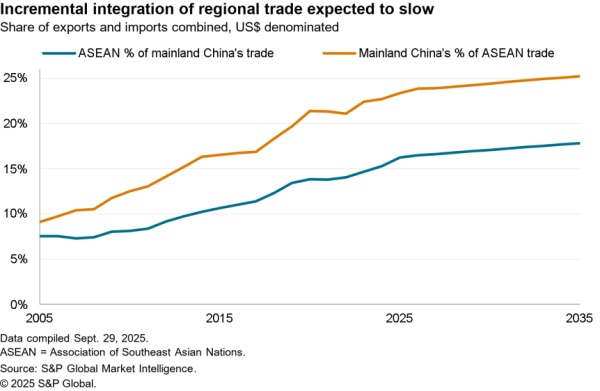This report eschews the normal “top 10 of the year” to instead pick one of the most read Panjiva Research reports from each month to provide a sense of how trade policy has evolved during the year. You can find a year’s worth of most-read research drawn from over 1,700 reports on a month-by-month basis here. Did we miss anything you want to know more about – email us via support@panjiva.com and let us know.
#1 TPP gone, NAFTA matters more (Jan 23)
As expected President Trump has withdrawn the U.S. from the Trans-Pacific Partnership trade deal, meeting one of his first day commitments. A renegotiation of NAFTA is likely to be next, and is arguably more important. Canada and Mexico accounted for 76% of the U.S. trade with TPP members, with Japan the only other major member at 10%. Panjiva data shows U.S. exports to TPP members expanded 8% in the quarter to November 30, whereas to NAFTA they fell 2%.

Source: Panjiva
#2 Trump, Trudeau and Peña Nieto’s pain points (Feb 3)
The Mexican government has started a 90 day process of consulting business on its NAFTA negotiating stance, though President Trump has called for the process to go more quickly. While talks will likely take years rather than months to complete, it is already possible to determine where each country’s pain points may be.
Panjiva’s analysis of the top 50 exports for each country reveals a simple negotiating grid. The most tightly integrated value chains are in automotives, electrical equipment (both domestic and utility scale) and computers. The first two are particularly important for Mexico. Energy flows from Canada and the U.S. matter greatly, while Canada is much more exposed than Mexico to primary materials including chemicals and steel. The main U.S. sensitivities are in electronics, particularly circuitry, and aerospace.

Source: Panjiva
#3 Mexico bares its teeth (Mar 15)
Mexico is preparing for NAFTA discussions by publicly stating it is looking to diversify its food supplies, Agriculture Secretary Jose Calzada is quoted as saying. Panjiva’s analysis of over 800 product-country pairs shows the U.S. accounts for 71.7% of Mexico main food supplies. Among basic products it is the main supplier except for fish (China), butter (New Zealand) and coffee (Vietnam).
The U.S. is also the main supplier of its processed foods ahead of Canada and China. The challenge for Mexico is in making the threat effective by finding the volumes required. In the meantime USTR nominee Robert Lighthizer wants to promote increased agricultural exports, but may find himself playing defense in the case of Mexico.

Source: Panjiva
#4 Not pushing the big red NAFTA button (Apr 26)
President Donald Trump’s administration has decided to proceed with NAFTA negotiations rather than trigger with a straight withdrawal. That shouldn’t be a surprise as Mexico and Canada want to negotiate, and the threat of leaving may just be “anchoring” before negotiations start. The next step is to start the 90 day consultation with Congress.
This could be ignored, but would make passing a deal through Congress at a later stage more difficult. Panjiva data shows NAFTA accounts for 18% of the U.S. deficit – the administration’s key trade metric. However, it also accounts for 34% of exports so a withdrawal would have had many losers.

Source: Panjiva
#5 138 days to get NAFTA done (May 18)
The U.S. Trade Representative has formally notified Congress of President Trump’s intention to renegotiate NAFTA. Initial details of the administration’s stance are few, but a comprehensive deal including new measures ranging from intellectual property to the environment are mentioned. There’s a 90 day consultation period with Congress, though full details of the administration’s stance aren’t required until 30 days before the end of the period.
Importantly, the administration has to provide a report to House Ways & Means on potential law changes needed 180 days before a deal is signed. Assuming a signature before the Mexican elections is needed, that would imply negotiations cannot take more than 138 days – ie to be completed by January 1 after being started on August 16. Before the agreement becomes law there are further administrative steps that could drag until February 2019, bringing the U.S. midterm elections into the equation. All this assumes Mexico and Canada are happy with the timetable of course.

Source: Panjiva
#6 Trump’s aluminum urgency (Jun 13)
The administration of President Donald Trump confirmed in a cabinet meeting yesterday that new rules on steel and aluminum imports will be sent to Congress shortly. That confirms comments from the President last week. There are reports, however, of pushback from government agencies that are concerned about the welfare of steel and aluminum buyers.
They would face higher costs in the event of tariffs or more expensive domestic manufacturing being substituted. Panjiva data shows a sense of urgency in completing new rules may be valid. Imports increased 37% on a year earlier in April, including a 53% rise in shipments from Canada and 50% from China. As a result imports on an annualized basis are 20% greater, and have reached their highest since at least 2009.

Source: Panjiva
#7 TPP reboot faces alphabet of competition (July 10)
Negotiators for the TPP trade deal will meet in Japan from July 12 to redesign the terms following America’s withdrawal. Technical factors such as entry-into-force thresholds will be easy to fix, and there are terms – such as healthcare – that were U.S. specific. Japan is the linchpin for the deal. It is the largest economy, and its exports to the group increased 4% on an annualized basis over the past four years while its imports fell 5%.
Australia and Malaysia will be particularly keen to increase their access to the Japanese market as their exports to Japan fell 10% and 13% respectively. TPP faces competition from the RCEP deal which includes most of the same countries. It is a simpler deal, and includes access to the much larger Chinese market. Japan is also trying to complete the EPA deal with Europe, which may absorb political time and capital.

Source: Panjiva
#8 “Terminate” losers = Michigan and Ohio (Aug 24)
President Trump’s renewed threat to “terminate” NAFTA has been largely shrugged off by leaders in Canada and Mexico. They may choose, however, to renew their charm offensive with U.S. states, as they did with governors in July. Panjiva analysis shows that among the larger states’ exports, Michigan has the most to “lose”, with 64% of state exports going to Canada and Mexico. It is also the third largest state by U.S. exports. Ohio has the fourth highest exposure at 51% and is the fifth largest exporting state. Among the larger, non-border states Michigan is the most significantly exposed to Mexico, and Indiana to Canada.

Source: Panjiva
#9 Steel can kicked down the road (Sept 22)
A decision by President Trump on action following the section 232 “national security” review of U.S. steel imports will not be made until after tax reform is concluded. The review faces three challenges. First is the potential for increased costs for U.S. manufacturers that use steel. Second is actually showing national security issues for specific products.
Third is determining who to target. Trade talks are already underway with Mexico, Canada, South Korea, Japan and India which together account for 37% of imports. Steel tariffs would complicate those discussions. Geopolitical tensions also overshadow relations with Russia and China, which account for 11% of the total and have grown 113% and 27% respectively in the past quarter on a year earlier.

Source: Panjiva
#10 NAFTA delay a good idea, for the wrong reason (Oct 25)
The fourth round of NAFTA negotiations went badly. While an extension of talks into 2018 raises the prospect of a deal ultimately being reached, it may lead to slower momentum at the November 17 round. Furthermore the delay is the result of intransigence. The U.S. continues to insist on a trade-deficit led approach, while Canada and Mexico are set against U.S. proposals on rules of origin and dispute settlement.
While the U.S. has no “active plans” to withdraw it may not “continue to encourage and guarantee” U.S. companies’ investments in Mexico or Canada. Panjiva data shows the largest U.S. domiciled exporters from Mexico to the U.S. are the two big automakers (Ford and General Motors) followed by brewer Constellation Brands. Ultimately none of the three countries can afford the disruption an end to NAFTA would bring. Canada and Mexico ship 75% and 80% respectively of their exports to the U.S., while 42% of U.S. exports go to Canada and Mexico.

Source: Panjiva
#11 President Trump Goes To Asia (Nov 14)
President Trump’s Asia trip delivered a message that “the rules have changed”. Reportedly a significant announcement is due on Wednesday from the White House on trade. In the meantime it is worth noting what was, and wasn’t, achieved. In Japan there were discussions on developing trade in autos (U.S. imports are 141x its exports), but the government remained resistant to a new trade deal.
The KORUS trade deal is already being “amended”, so talks focussed more on security issues. That included the potential for “billions of dollars” of military sales to South Korea – on top of annual sales of $11 billion already.
The President’s China visit included the signing of $253 billion of corporate contracts and MoUs, but not movement on trade relations more broadly. That will have to await completion of America’s “section 301” review of Chinese intellectual property practices and China’s complaint about its “market economy status” at the WTO.
Vietnam similarly included $12 billion of trade contracts, but not broader deal emerged to cut America’s $38 billion deficit. Finally at the APEC summit the difference between “America First” and China’s multilateral deal-making was clear. The U.S. runs the risk of eventually facing a broad-based APEC trade group that accounts for 77% of its trade deficit and will be difficult to deal with. The bottom line: President Trump’s message on trade was delivered, lots of contracts were signed but no movement on broader trade policy occurred.

Source: Panjiva
#12 The first shot in 2018’s trade war (Dec 18)
The Chinese Ministry of Finance has cut a series of export duties as part of its usual year-end reforms. In steel there were tariff cuts for 17 products (with duties down an average 26%), with 25 reductions in aluminum rates and 32 in copper. The move comes just after a commitment by the EU, Japan and U.S. to tackle “excess capacity” industries. Yet, a removal of tariffs arguably represents a removal of market distortions, and so would be inline with the G20’s steel forum aims.

Source: Panjiva




